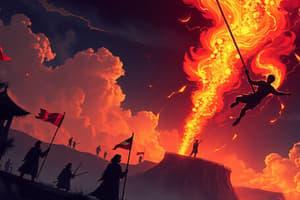Podcast
Questions and Answers
What is the full name of the revolutionary society established by Filipino nationalists?
What is the full name of the revolutionary society established by Filipino nationalists?
- Kataastaasang, Katipunan ng mga Anak ng Bayan
- Kataastaasang, Kagalanggalangang, Katipunan
- Kagalanggalangang, Katipunan ng mga Anak ng Bayan
- Kataastaasang, Kagalanggalangang, Katipunan ng mga Anak ng Bayan (correct)
Who led the revolutionary society and aimed to build organization for revolution?
Who led the revolutionary society and aimed to build organization for revolution?
- Valentin Diaz
- Andres Bonifacio (correct)
- Ladislao Diwa
- Teodoro Plata
What was the primary objective of the revolutionary society?
What was the primary objective of the revolutionary society?
- Legal, administrative, and ethical
- Religious, educational, and military
- Economic, social, and cultural
- Civil, political, and moral (correct)
Which council served as the highest governing body in the revolutionary society?
Which council served as the highest governing body in the revolutionary society?
What was the name of the street in Manila where the revolutionary society gathered on July 7, 1892?
What was the name of the street in Manila where the revolutionary society gathered on July 7, 1892?
Who was not one of the leaders of the Katipunan?
Who was not one of the leaders of the Katipunan?
What was the purpose of the blood compact among the leaders of the Katipunan?
What was the purpose of the blood compact among the leaders of the Katipunan?
Which council served as the municipal government in the Katipunan organization?
Which council served as the municipal government in the Katipunan organization?
What was the primary objective of the Katipunan?
What was the primary objective of the Katipunan?
What was the original name of the street in Manila where the Katipunan gathered on July 7, 1892?
What was the original name of the street in Manila where the Katipunan gathered on July 7, 1892?
Flashcards are hidden until you start studying
Study Notes
Revolutionary Society Overview
- Full name: Katipunan, formally known as "Katipunan ng mga Anak ng Bayan"
- Founded by Filipino nationalists in pursuit of independence from Spanish colonial rule.
Leadership and Organization
- Led by Andrés Bonifacio, who aimed to organize efforts for revolution.
- His leadership focused on empowering Filipinos to fight for their rights and freedom.
Primary Objectives
- Objective: Securing independence from Spanish rule through revolution.
- Promoted equality, national identity, and liberation among Filipinos.
Governance Structure
- The highest governing body: "Katipunan Council," which made significant decisions regarding the organization’s direction.
- Municipal government functioned through local councils within the Katipunan framework.
Historical Gathering Place
- Street where Katipunan gathered on July 7, 1892: Calle Azcárraga, later known as Rizal Avenue.
- This location became symbolic in the history of the Philippine revolution.
Key Figures and Events
- Notable leaders of the Katipunan included Bonifacio, Emilio Jacinto, and Apolinario Mabini.
- José Rizal, a prominent nationalist, was not involved in the leadership of the Katipunan.
Cultural Significance
- The blood compact ritual, known as "Sanduguan," among Katipunan leaders symbolized their unity and commitment to the cause.
- This ceremonial act reinforced solidarity and the seriousness of their objectives.
Conclusion
- The Katipunan represents a critical movement towards Filipino independence showcasing the fight against colonial oppression.
- Its legacy continues to influence nationalism in the Philippines today.
Studying That Suits You
Use AI to generate personalized quizzes and flashcards to suit your learning preferences.





